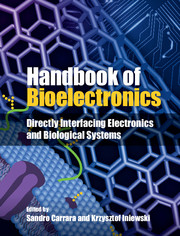Book contents
- Frontmatter
- Contents
- List of Contributors
- 1 What is bioelectronics?
- Part I Electronic components
- 2 Molecular components for electronics
- 3 Nanogaps and biomolecules
- 4 Organic thin-film transistors for biological applications
- 5 Protein-based transistors
- 6 Single-molecule bioelectronics
- 7 Nanoscale biomemory device composed of recombinant protein variants
- Part II Biosensors
- Part III Fuel cells
- Part IV Biomimetic systems
- Part V Bionics
- Part VI Brain interfaces
- Part VII Lab-on-a-chip
- Part VIII Future perspectives
- Index
- References
4 - Organic thin-film transistors for biological applications
from Part I - Electronic components
Published online by Cambridge University Press: 05 September 2015
- Frontmatter
- Contents
- List of Contributors
- 1 What is bioelectronics?
- Part I Electronic components
- 2 Molecular components for electronics
- 3 Nanogaps and biomolecules
- 4 Organic thin-film transistors for biological applications
- 5 Protein-based transistors
- 6 Single-molecule bioelectronics
- 7 Nanoscale biomemory device composed of recombinant protein variants
- Part II Biosensors
- Part III Fuel cells
- Part IV Biomimetic systems
- Part V Bionics
- Part VI Brain interfaces
- Part VII Lab-on-a-chip
- Part VIII Future perspectives
- Index
- References
Summary
Abstract
In the past few years biosensing concepts based on organic field-effect transistors (OFETs) have attracted more and more attention. Here organic electronics benefit especially from the fact that solution-processable organic thin films can be used in flexible and disposable sensors. Additionally, the outstanding biocompatibility of many organic materials allows the use of organic sensing devices for in-vivo applications and permits the design of biodegradable sensors.
Starting from the basic principles of organic thin-film transistors, this chapter will present the state of the art of biosensing approaches based on OFETs, either back-gated or electrolyte-gated, focusing in particular on different functionalization methods to achieve a selective response of the OFET towards biologically relevant molecules. We present recently published applications of organic thin-film transistors ranging from the detection of biomolecules such as DNA, proteins, and enzymes to the sensing and stimulation of electrical activity potentials of neurons. The sensing mechanism and the influence of the Debye screening length on the detection of biomolecules will be discussed.
Background and introduction
Early and correct diagnosis of diseases plays a crucial role in modern medicine. For several decades researchers have been working on the discovery of biomarkers, molecular indicators giving early information about various diseases. For detection of the increasing number of biomarkers, low-cost, fast, and reliable methods are required.
- Type
- Chapter
- Information
- Handbook of BioelectronicsDirectly Interfacing Electronics and Biological Systems, pp. 34 - 48Publisher: Cambridge University PressPrint publication year: 2015



